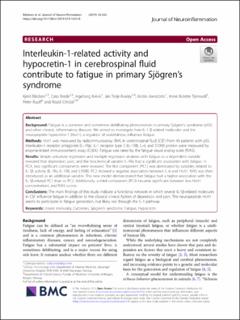| dc.contributor.author | Bårdsen, Kjetil | |
| dc.contributor.author | Brede, Cato | |
| dc.contributor.author | Kvivik, Ingeborg | |
| dc.contributor.author | Kvaløy, Jan Terje | |
| dc.contributor.author | Jonsdottir, Kristin | |
| dc.contributor.author | Tjensvoll, Anne Bolette | |
| dc.contributor.author | Ruoff, Peter | |
| dc.contributor.author | Omdal, Roald | |
| dc.date.accessioned | 2021-03-10T13:30:12Z | |
| dc.date.available | 2021-03-10T13:30:12Z | |
| dc.date.created | 2019-07-04T13:23:18Z | |
| dc.date.issued | 2019 | |
| dc.Published | Journal of Neuroinflammation. 2019, 16 1-9. | |
| dc.identifier.issn | 1742-2094 | |
| dc.identifier.uri | https://hdl.handle.net/11250/2732660 | |
| dc.description.abstract | Background
Fatigue is a common and sometimes debilitating phenomenon in primary Sjögren’s syndrome (pSS) and other chronic inflammatory diseases. We aimed to investigate how IL-1 β-related molecules and the neuropeptide hypocretin-1 (Hcrt1), a regulator of wakefulness, influence fatigue.
Methods
Hcrt1 was measured by radioimmunoassay (RIA) in cerebrospinal fluid (CSF) from 49 patients with pSS. Interleukin-1 receptor antagonist (IL-1Ra), IL-1 receptor type 2 (IL-1RII), IL-6, and S100B protein were measured by enzyme-linked immunosorbent assay (ELISA). Fatigue was rated by the fatigue visual analog scale (fVAS).
Results
Simple univariate regression and multiple regression analyses with fatigue as a dependent variable revealed that depression, pain, and the biochemical variable IL-1Ra had a significant association with fatigue. In PCA, two significant components were revealed. The first component (PC1) was dominated by variables related to IL-1β activity (IL-1Ra, IL-1RII, and S100B). PC2 showed a negative association between IL-6 and Hcrt1. fVAS was then introduced as an additional variable. This new model demonstrated that fatigue had a higher association with the IL-1β-related PC1 than to PC2. Additionally, a third component (PC3) became significant between low Hcrt1 concentrations and fVAS scores.
Conclusions
The main findings of this study indicate a functional network in which several IL-1β-related molecules in CSF influence fatigue in addition to the classical clinical factors of depression and pain. The neuropeptide Hcrt1 seems to participate in fatigue generation, but likely not through the IL-1 pathway. | en_US |
| dc.language.iso | eng | en_US |
| dc.publisher | BMC | en_US |
| dc.rights | Navngivelse 4.0 Internasjonal | * |
| dc.rights.uri | http://creativecommons.org/licenses/by/4.0/deed.no | * |
| dc.title | Interleukin-1-related activity and hypocretin-1 in cerebrospinal fluid contribute to fatigue in primary Sjögren’s syndrome | en_US |
| dc.type | Journal article | en_US |
| dc.type | Peer reviewed | en_US |
| dc.description.version | publishedVersion | en_US |
| dc.rights.holder | Copyright The Author(s). 2019 | en_US |
| dc.source.articlenumber | 102 | en_US |
| cristin.ispublished | true | |
| cristin.fulltext | original | |
| cristin.qualitycode | 1 | |
| dc.identifier.doi | 10.1186/s12974-019-1502-8 | |
| dc.identifier.cristin | 1710129 | |
| dc.source.journal | Journal of Neuroinflammation | en_US |
| dc.source.40 | 16 | |
| dc.identifier.citation | Journal of Neuroinflammation. 2019, 16, 102. | en_US |
| dc.source.volume | 16 | en_US |

